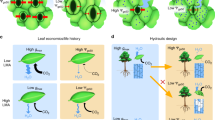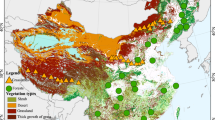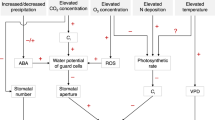Abstract
Stomata, the small pores on the surfaces of leaves and stalks, regulate the flow of gases in and out of leaves and thus plants as a whole. They adapt to local and global changes on all timescales from minutes to millennia. Recent data from diverse fields are establishing their central importance to plant physiology, evolution and global ecology. Stomatal morphology, distribution and behaviour respond to a spectrum of signals, from intracellular signalling to global climatic change. Such concerted adaptation results from a web of control systems, reminiscent of a ‘scale-free’ network, whose untangling requires integrated approaches beyond those currently used.
This is a preview of subscription content, access via your institution
Access options
Subscribe to this journal
Receive 51 print issues and online access
$199.00 per year
only $3.90 per issue
Buy this article
- Purchase on Springer Link
- Instant access to full article PDF
Prices may be subject to local taxes which are calculated during checkout





Similar content being viewed by others
References
Raven, J. Selection pressures on stomatal evolution. New Phytol. 153, 371–386 (2002)
Willmer, C. & Fricker, M. Stomata 2nd edn (Chapman & Hall, London, 1996)
Jackson, R. B. et al. Water in a changing world. Ecol. Appl. 11, 1027–1045 (2001)
Cramer, W. et al. Global response of terrestrial ecosystem structure and function to CO2 and climate change: results from six dynamic global vegetation models. Global Change Biol. 7, 357–373 (2001)
Ciais, P. et al. A three-dimensional synthesis study of δO18 in atmospheric CO2. I. Surface fluxes. J. Geophys. Res. Atmos. 102, 5857–5872 (1997)
Edwards, D., Kerp, H. & Hass, H. Stomata in early land plants: an anatomical and ecophysiological approach. J. Exp. Bot. 49, 255–278 (1998)
Beerling, D. J. & Woodward, F. I. Changes in land plant function over the Phanerozoic: reconstructions based on the fossil record. Bot. J. Linn. Soc. 124, 137–153 (1997)
Woodward, F. I. Do plants really need stomata? J. Exp. Bot. 49, 471–480 (1998)
Janis, C. M. Tertiary mammal evolution in the context of changing climates, vegetation, and tectonic events. Annu. Rev. Ecol. Syst. 24, 467–500 (1993)
Mast, A. R. & Givnish, T. J. Historical biogeography and the origin of stomatal distributions in Banksia and Dryandra (Proteaceae) based on their cpDNA phylogeny. Am. J. Bot. 89, 1311–1323 (2002)
Hill, R. S. (ed.) History of the Australian Vegetation (Cambridge Univ. Press, Cambridge, 1994)
Aronne, G. & De Micco, V. Seasonal dimorphism in the Mediterranean Cistus incanus L. subsp. incanus. Ann. Bot. 87, 789–794 (2001)
Kellogg, E. A. Evolutionary history of the grasses. Plant Physiol. 125, 1198–1205 (2001)
Palevitz, B. A. in Stomatal Physiology (eds Jarvis, P. G. & Mansfield, T. A.) 1–23 (Cambridge Univ. Press, Cambridge, 1981)
Raschke, K. in Encyclopedia of Plant Physiology Vol. 7 (eds Haupt, W. & Feinleib, M. E.) 383–441 (Springer, Berlin, 1979)
Grantz, D. A. & Assmann, S. M. Stomatal response to blue-light—water-use efficiency in sugarcane and soybean. Plant Cell Environ. 14, 683–690 (1991)
Wever, L. A., Flanagan, L. B. & Carlson, P. J. Seasonal and interannual variation in evapotranspiration, emergy balance and surface conductance in a northern temperate grassland. Agric. For. Meteorol. 112, 31–49 (2002)
Retallack, G. J. Cenozoic expansion of grasslands and climatic cooling. J. Geol. 109, 407–426 (2001)
Aasamaa, K., Sober, A. & Rahi, M. Leaf anatomical characteristics associated with shoot hydraulic conductance, stomatal conductance and stomatal sensitivity to changes of leaf water status in temperate deciduous trees. Aust. J. Plant Physiol. 28, 765–774 (2001)
Meidner, H. & Mansfield, T. A. Physiology of Stomata (McGraw-Hill, London, 1968)
Allen, M. T. & Pearcy, R. W. Stomatal behavior and photosynthetic performance under dynamic light regimes in a seasonally dry tropical rain forest. Oecologia 122, 470–478 (2000)
Woodward, F. I., Lake, J. A. & Quick, W. P. Stomatal development and CO2: ecological consequences. New Phytol. 153, 477–484 (2002)
Royer, D. L. Stomatal density and stomatal index as indicators of paleoatmospheric CO2 concentration. Rev. Palaeobot. Palyno. 114, 1–28 (2001)
Gray, J. E. et al. The HIC signalling pathway links CO2 perception to stomatal development. Nature 408, 713–716 (2000)
Chen, X., Goodwin, M. S., Boroff, V. L., Liu, X. & Jenks, M. A. Cloning and characterization of the WAX2 gene of Arabidopsis involved in cuticle membrane and wax production. Plant Cell 15, 1170–1185 (2003)
Lake, J. A., Woodward, F. I. & Quick, W. P. Long-distance CO2 signalling in plants. J. Exp. Bot. 53, 183–193 (2002)
Penninckx, I. A. M. A., Thomma, B. P. H. J., Buchala, A., Metraux, J. P. & Broekaert, W. F. Concomitant activation of jasmonate and ethylene response pathways is required for induction of a plant defensin gene in Arabidopsis. Plant Cell 10, 2103–2113 (1998)
Adam, L. et al. Comparison of Erysiphe cichoracearum and E. cruciferarum and a survey of 360 Arabidopsis thaliana successions for resistance to these two powdery mildew pathogens. Mol. Plant Microbe Interact. 12, 1031–1043 (1999)
Lake, J. A., Quick, W. P., Beerling, D. J. & Woodward, F. I. Signals from mature to new leaves. Nature 411, 154–155 (2001)
Maldonado, A. M., Doerner, P., Dixon, R. A., Lamb, C. J. & Cameron, R. K. A putative lipid transfer protein involved in systemic resistance signalling in Arabidopsis. Nature 419, 399–403 (2002)
Heichel, G. H. & Anagnostakis, S. L. Stomatal response to light of Solanum pennelli, Lycopersicon esculentum, and a graft-induced chimera. Plant Physiol. 62, 387–390 (1978)
Schroeder, J. I., Allen, G. J., Hugouvieux, V., Kwak, J. M. & Waner, D. Guard cell signal transduction. Annu. Rev. Plant Physiol. Plant Mol. Biol. 52, 627–658 (2001)
Hetherington, A. M. Guard cell signaling. Cell 107, 711–714 (2001)
McAinsh, M. R. & Hetherington, A. M. Encoding specificity in Ca2+ signalling systems. Trends Plant Sci. 3, 32–36 (1998)
Roelfsema, M. R. G. & Prins, H. B. A. Effect of abscisic acid on stomatal opening in isolated epidermal strips of abi mutants of Arabidopsis thaliana. Physiol. Plant. 95, 373–378 (1995)
Webb, A. A. R. & Hetherington, A. M. Convergence of the abscisic acid, CO2, and extracellular calcium signal transduction pathways in stomatal guard cells. Plant Physiol. 114, 1557–1560 (1997)
Leymarie, J., Lasceve, G. & Vavasseur, A. Interaction of stomatal responses to ABA and CO2 on Arabidopsis thaliana. Aust. J. Plant Physiol. 25, 785–791 (1998)
Leymarie, J., Vavasseur, A. & Lasceve, G. CO2 sensing in stomata of abi1-1 and abi2-1 mutants of Arabidopsis thaliana. Plant Physiol. Biochem. 36, 539–543 (1998)
Albert, R., Jeong, H. & Barabasi, A.-L. Error and attack tolerance of complex networks. Nature 406, 378–382 (2000)
Strogatz, S. H. Exploring complex networks. Nature 410, 268–276 (2001)
Barabasi, A.-L. Linked the New Science of Networks 280 (Perseus, Massachusetts, 2002)
Kinoshita, T. et al. phot1 and phot2 mediate blue light regulation of stomatal opening. Nature 414, 656–660 (2001)
Hunt, L. et al. Phospholipase C is required for the control of stomatal aperture by ABA. Plant J. 34, 47–55 (2003)
Webb, A. A. R., Larman, M. G., Montgomery, L. T., Taylor, J. E. & Hetherington, A. M. The role of calcium in ABA-induced gene expression and stomatal movements. Plant J. 26, 351–362 (2001)
Frechilla, F., Talbott, L. D. & Zeiger, E. The CO2 response of Vicia guard cells acclimates to growth environment. J. Exp. Bot. 53, 545–550 (2002)
Medlyn, B. E. et al. Stomatal conductance of forest species after long-term exposure to elevated CO2 concentration: a synthesis. New Phytol. 149, 247–264 (2001)
Woodward, F. I. & Kelly, C. K. The influence of CO2 concentration on stomatal density. New Phytol. 131, 311–327 (1995)
Leymarie, J., Lasceve, G. & Vavasseur, A. Elevated CO2 enhances stomatal responses to osmotic stress and abscisic acid in Arabidopsis thaliana. Plant Cell. Environ. 22, 301–308 (1999)
Webb, A. A. R. in Biological Rhythms and Photoperiodism in Plants (eds Lumsden, P. J. & Millar, A. J.) 69–79 (Bios, Oxford, 1998)
Talbott, L. D. & Zeiger, E. The role of sucrose in guard cell osmoregulation. J. Exp. Bot. 49, 329–337 (1998)
Seidman, G. & Riggan, W. B. Stomatal movements: a yearly rhythm. Nature 217, 684–685 (1968)
Thiel, G., MacRobbie, E. A. C. & Blatt, M. R. Membrane transport in stomatal guard cells—the importance of voltage control. J. Membr. Biol. 126, 1–18 (1992)
Lohse, G. & Hedrich, R. Characterization of the plasma membrane H + ATPase from Vicia faba guard cells modulation by extracellular factors and seasonal changes. Planta 188, 206–214 (1992)
Willmer, C. & Sexton, R. Stomata and plasmodesmata. Protoplasma 100, 113–124 (1979)
Leckie, C. P., McAinsh, M. R., Allen, G. J., Sanders, D. & Hetherington, A. M. Abscisic acid induced stomatal closure mediated by cyclic ADP ribose. Proc. Natl Acad. Sci. USA 95, 15837–15842 (1998)
Weyers, J. D. B. & Lawson, T. Heterogeneity in stomatal characteristics. Adv. Bot. Res. 26, 317–352 (1997)
Mott, K. A. & Buckley, T. N. Patchy stomatal conductance: emergent collective behaviour of stomata. Trends Plant Sci. 5, 258–262 (2000)
Farquhar, G. D., Von Caemmerer, S. & Berry, J. A. A biochemical model of photosynthetic CO2 assimilation in leaves of C3 species. Planta 149, 78–90 (1980)
Jarvis, A. J., Mansfield, T. A. & Davies, W. J. Stomatal behaviour, photosynthesis and transpiration under rising CO2 . Plant Cell Environ. 22, 639–648 (1999)
Wullschleger, S. D., Tschaplinski, T. J. & Norby, R. J. Plant water relations at elevated CO2—implications for water-limited environments. Plant Cell Environ. 25, 319–331 (2002)
Woodward, F. I. Potential impacts of global elevated CO2 concentrations on plants. Curr. Opin. Plant Biol. 5, 207–211 (2002)
Lu, Z., Percy, R. G., Qualset, C. O. & Zeiger, E. Stomatal conductance predicts yields in irrigated Pima cotton and bread wheat grown in high temperatures. J. Exp. Bot. 49, 453–460 (1998)
Dudley, S. A. Differing selection on plant physiological traits in response to environmental water availability: a test of adaptive hypotheses. Evolution 50, 92–102 (1996)
Case, A. L. & Barrett, S. C. H. Ecological differentiation of combined and separate sexes of Wurmbea dioica (Colchicaceae) in sympatry. Ecology 82, 2601–2616 (2001)
Avery, L. & Wasserman, S. Ordering gene function: the interpretation of epistasis in regulatory hierarchies. Trends Genet. 8, 312–316 (1992)
Bredenkamp, G. J., Spada, F. & Kazmierczak, E. On the origin of northern and southern hemisphere grasslands. Plant Ecol. 163, 209–229 (2002)
Sugden, A. M. Leaf anatomy in a Venezuelan montane forest. Bot. J. Linn. Soc. 90, 231–241 (1985)
Tanner, E. V. J. & Kapos, V. Leaf structure of Jamaican upper montane rain-forest trees. Biotropica 14, 16–24 (1982)
Knapp, A. K. Gas exchange dynamics on C3 and C4 grasses: consequences of differences in stomatal conductance. Ecology 74, 113–123 (1993)
Li, W. L., Berlyn, G. P. & Ashton, P. M. S. Polyploids and their structural and physiological characteristics relative to water deficit in Betula papyrifera (Betulaceaea). Am. J. Bot. 83, 15–20 (1996)
Blanke, M. M., Höfer, M. & Pring, R. J. Stomata and structure of tetraploid apple leaves cultured in vitro. Ann. Bot. 73, 651–654 (1994)
Mitton, J. B., Grant, M. C. & Yoshino, A. M. Variation in allozymes and stomatal size in pinyon (Pinus edulis, Pinaceae), associated with soil moisture. Am. J. Bot. 85, 1262–1265 (1998)
Jones, H. G. Transpiration in barley lines with differing stomatal frequencies. J. Exp. Bot. 28, 162–168 (1977)
Mishra, M. K. Stomatal characteristics at different ploidy levels in Coffea L. Ann. Bot. 80, 689–692 (1997)
Knapp, A. K., Cocke, M., Hamerlynck, E. P. & Owensby, C. E. Effect of elevated CO2 on stomatal density and distribution in a C4 grass and a C3 forb under field conditions. Ann. Bot. 74, 595–599 (1994)
McConathy, R. K. Tulip-poplar leaf diffusion resistance calculated from stomatal dimensions and varying environmental parameters. For. Sci. 29, 139–148 (1983)
Gindel, I. Stomata constellation in the leaves of cotton, maize and wheat plants as a function of soil moisture and environment. Physiol. Plant. 22, 1143–1151 (1969)
Anderson, L. J., Maherali, H., Johnson, H. B., Polley, H. W. & Jackson, R. B. Gas exchange and photosynthetic acclimation over subambient to elevated CO2 in a C3–C4 grassland. Global Change Biol. 7, 693–707 (2001)
Cavender-Bares, J. & Bazzaz, F. A. Changes in drought response strategies with ontogeny in Quercus rubra: implications for scaling from seedlings to mature trees. Oecologia 124, 8–18 (2000)
Ellsworth, D. S. CO2 enrichment in a maturing pine forest: are CO2 exchange and water status in the canopy affected? Plant Cell Environ. 22, 461–472 (1999)
Escalona, M. H., Bota, J. M., Gulias, J. & Flexas, J. Regulation of photosynthesis of C-3 plants in response to progressive drought: stomatal conductance as a reference parameter. Ann. Bot. 89, 895–905 (2002)
Fetene, M., Nauke, P., Lüttge, U. & Beck, E. Photosynthesis and photoinhibition in a tropical alpine giant rosette plant, Lobelia rhynchopetalum. New Phytol. 137, 453–461 (1997)
Franco, A. C. & Lüttge, U. Midday depression in savanna trees: coordinated adjustments in photochemical efficiency, photorespiration, CO2 assimilation and water use efficiency. Oecologia 131, 356–365 (2002)
Garcia, R. L. et al. Photosynthesis and conductance of spring-wheat leaves: field response to continuous free-air atmospheric CO2 enrichment. Plant Cell Environ. 21, 659–669 (1998)
Giorio, P., Sorrentino, G. & d'Andria, R. Stomatal behaviour, leaf water status and photosynthetic response in field-grown olive trees under water deficit. Environ. Exp. Bot. 42, 95–104 (1999)
Hamerlynck, E. P., Huxman, T. E., Charlet, T. N. & Smith, S. D. Effects of elevated CO2 (FACE) on the functional ecology of the drought-deciduous Mojave Desert shrub. Lycium andersonii. Environ. Exp. Bot. 48, 93–106 (2002)
Hirasawa, T. & Hsiao, T. C. Some characteristics of reduced leaf photosynthesis at midday in maize growing in the field. Field Crops Res. 62, 53–62 (1999)
Huxman, T. E. & Smith, S. D. Photosynthesis in an invasive grass and native forb at elevated CO2 during an El Niño year in the Mojave Desert. Oecologia 128, 193–201 (2001)
Jiang, G. M. & Zhu, G. J. Different patterns of gas exchange and photochemical efficiency in three desert shrub species under two natural temperatures and irradiances in Mu Us Sandy Area of China. Photosynthetica 39, 257–262 (2001)
Kaiser, H. & Kappen, L. In situ observation of stomatal movements and gas exchange of Aegopodium podagraria L. in the understorey. J. Exp. Bot. 51, 1741–1749 (2000)
Kazda, M., Salzer, J. & Reiter, I. Photosynthetic capacity in relation to nitrogen in the canopy of a Quercus robur, Fraxinus angustifolia and Tilia cordata flood plain forest. Tree Physiol. 20, 1029–1037 (2000)
Knapp, A. K. Gas exchange dynamics in C3 and C4 grasses: consequences of differences in stomatal conductance. Ecology 74, 113–123 (1993)
Lee, T. D., Tjoelker, M. G., Ellsworth, D. S. & Reich, P. B. Leaf gas exchange responses of 13 prairie grassland species to elevated CO2 and increased nitrogen supply. New Phytol. 150, 405–418 (2001)
Lodge, R. J., Dijkstra, P., Drake, B. G. & Morison, J. I. L. Stomatal acclimation to increased CO2 concentration in a Florida scrub oak species Quercus myrtifolia Willd. Plant Cell Environ. 24, 77–88 (2001)
McCarron, J. K. & Knapp, A. K. C3 woody plant expansion in a C4 grassland: are grasses and shrubs functionally distinct? Am. J. Bot. 88, 1818–1823 (2001)
Medlyn, B. E., Loustau, D. & Delzon, S. Temperature response of parameters of a biochemically based model of photosynthesis. I. Seasonal changes in mature maritime pine (Pinus pinaster Ait.). Plant Cell Environ. 25, 1155–1165 (2002)
Pääkkönen, E., Vahala, J., Pohjola, M., Holopainen, T. & Kärenlampi, L. Physiological, stomatal and ultrastructural ozone responses in birch (Betula pendula Roth.) are modified by water stress. Plant Cell Environ. 21, 671–684 (1998)
Turnbull, M. H. et al. Photosynthetic characteristics in canopies of Quercus rubra, Quercus prinus and Acer rubrum differ in response to soil water availability. Oecologia 130, 515–524 (2002)
Yoder, B. J., Ryan, M. G., Waring, R. H., Schoettle, A. W. & Kaufmann, M. R. Evidence of reduced photosynthetic rates in old trees. For. Sci. 40, 513–527 (1994)
Yu, G. R., Zhuang, J. & Yu, Z. L. An attempt to establish a synthetic model of photosynthesis-transpiration based on stomatal behavior for maize and soybean plants grown in field. J. Plant Physiol. 158, 861–874 (2001)
Acknowledgements
A.M.H. wishes to acknowledge the support of the BBSRC to further stomatal research in his laboratory and the Fellows of St Catherine's College, Oxford, for the award of a Christensen Visiting Fellowship. F.I.W. is pleased to acknowledge support from NERC to further his stomatal research. We also wish to acknowledge G. Farquhar, J. Raven, M. Blatt, A. Webb, B. Davies, C. Price, N. Battey and J. Lake for providing input during the writing of this review, and L. Hunt, J. Gray and L. Mills for the stomatal images.
Author information
Authors and Affiliations
Corresponding author
Rights and permissions
About this article
Cite this article
Hetherington, A., Woodward, F. The role of stomata in sensing and driving environmental change. Nature 424, 901–908 (2003). https://doi.org/10.1038/nature01843
Issue Date:
DOI: https://doi.org/10.1038/nature01843
This article is cited by
-
Light-induced stomatal opening requires phosphorylation of the C-terminal autoinhibitory domain of plasma membrane H+-ATPase
Nature Communications (2024)
-
Effects of Warming and Elevated CO2 on Stomatal Conductance and Chlorophyll Fluorescence of C3 and C4 Coastal Wetland Species
Wetlands (2024)
-
Light and dispersal strategies structure palm community along an elevation gradient in the Atlantic Forest
Brazilian Journal of Botany (2024)
-
SCAB1 coordinates sequential Ca2+ and ABA signals during osmotic stress induced stomatal closure in Arabidopsis
Science China Life Sciences (2024)
-
Study on the impact of exogenously applied methyl jasmonate concentrations on Solanum lycopersicum under low temperature stress
BMC Plant Biology (2023)
Comments
By submitting a comment you agree to abide by our Terms and Community Guidelines. If you find something abusive or that does not comply with our terms or guidelines please flag it as inappropriate.



